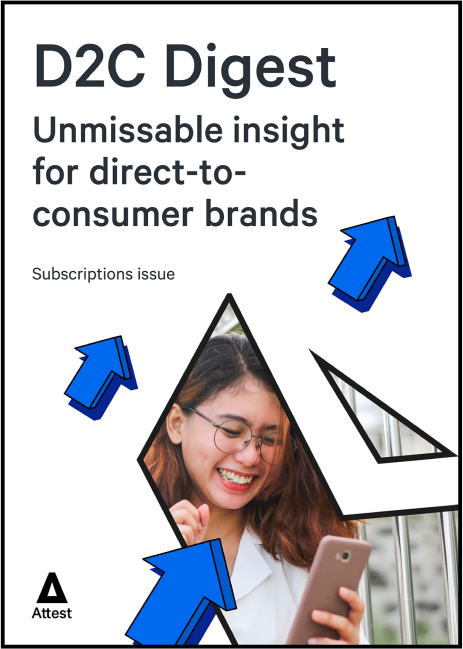What ‘value for money’ means to D2C customers

'Value for money' is a term that has different meanings to different consumers, and that's before you break down what it means from industry to industry. Here's our deep dive into what it means to D2C customers and how it affects people's views of the sector.
Welcome to Attest Investigates! A series where I use the Attest platform to test anyone’s hypotheses and answer your burning questions.
As a scientist, I am obsessed with experimentation, empiricism and using data to make decisions. We’ll delve into all things consumer research to lift the lid on the most important unknowns for brands, as requested by you!
Introduction and hypothesis
What do the concepts of ‘value for money’ and ‘affordable quality’ mean to you?
When all’s said and done, this is the issue at the crux of what brands like to offer. Provide value for money to your customers and you’ll have created a loyal customer and a brand advocate.
In this edition of Attest Investigates we deal with what value for money actually means to a massive and still-growing group of people: D2C customers. Adding to this, we also explore whether people are willing to pay more to avoid any possible drawbacks of shopping D2C.
Here’s my hypothesis for this research: for D2C customers, ‘value for money’ will have taken on new meanings when covering D2C vs. non-D2C. In D2C, customers include (and therefore brands must recognise) the concept of value in things like home delivery product exclusivity too. In D2C this is all wrapped-up in one idea… but behind the scenes is much more complex.

Method
We surveyed a nationally representative sample of 500 Brits for this research.
Do head over to the Attest dashboard where you can see the full results and dig into results from different demographics.
Results
Value for money trumps (almost) everything
We asked people to rank features of D2C shopping in terms of ‘which of the following factors is most important to you?’, and ‘value for money’ is the clear overall priority. A hefty 57% ranked it in first or second place.
It didn’t, however, take the overall top spot. Edging out value for money was ‘quality of products’, for which 59% placed it first or second out of seven D2C factors.
While it’s a close race at the top, none of the other choices came even close in importance:
- Free or low-cost delivery: 26%
- Wide range of products: 19%
- Brand reputation: 17%
- Returns policy: 12%
- Customer experience: 11%
In D2C, we often spend a lot of time talking about these lower-priority factors. Sometimes because a minimum threshold of performance is required (customer experience, returns). Sometimes because these are interesting and valuable levers for D2C companies to play with (brand, range). However, all of them are clearly much less important than the fundamentals: value and quality.
The combination of value and quality is all-powerful in D2C – but what does that actually mean, how do consumers really think about that, and what different interpretations exist?

Value for money = Affordable quality
Nearly a third (32%) of our respondents said that ‘affordable quality’ best describes what value for money means to them. In fact, this was the standout definition:
- Affordable quality: 32%
- Buying something that will last a long time: 20%
- Feeling like I’m getting more than I actually pay for: 19%
- Buying something I will use a lot: 16%
- Paying the lowest price: 13%
When we dig into demographics, we find that ‘affordable quality’ is consistently in the top spot across almost all consumer groups. When we drill down even further, we find even more confidence. For instance, 33% of under 30s put ‘affordable quality’ at the top, and we see just 0.1% difference between how males and females place it. ‘Affordable quality’ is the dominant definition, even though different varieties and flavours do exist.
There is a female/male split further down the list, however. While females mirror the general population, males chose slightly differently. Their second choice was ‘feeling like l’m getting more than I actually pay for’ (with 22% choosing this), usurping the overall #2 (‘buying something that will last a long time’ – 17% of males chose this).
That’s an interesting and important variant of this theme, which can help understand and unlock this important concept in D2C marketing and propositions aimed at different genders.
How to remove D2C barriers, and convert D2C newbies
It’s equally important to research why consumers don’t buy or try, as well as why they do.
Narrowing down our results to see what’s deterring those new to D2C from taking the plunge, we see that their main concern is not being able to do all of their shopping in one place. While respondents overall ranked this a lowly sixth out of nine, a significant 45% of people who haven’t bought D2C in the last year said this is why. Big opportunity here.
This appears to reemphasize the importance of marketplaces, which we originally uncovered in our D2C Digest from 2021. We found then that 71% of people agreed that marketplaces help them to discover new brands, and that 53% said they were more likely to try a new brand on a marketplace than directly with the brand’s own website. Knocking-down barriers to trial and purchase is one of the most valuable forms of research you can do, to solve one of the most valuable opportunities.
Would people pay more to avoid D2C drawbacks?
For the many wonderful reasons to shop D2C, there are certainly areas in which the industry is developing. We asked whether people would pay more to avoid some of these drawbacks. Overall people wouldn’t be willing to pay more – no great surprise there.
Where the results get really interesting are when we look at what people would be willing to pay a little more to avoid. The results for this option were:
- Delivery time/cost: 49%
- Inconvenience of returning products: 30%
- Concerns about data security: 30%
- Lack of choice: 30%
- Difficulty finding what I want: 27%
- Inability to see/try products in real life: 27%
Across all of these factors, we also see that under 30s over-index for each of these factors – they’re even more willing to pay more to avoid these potential pitfalls. Again, here we’ve uncovered an opportunity; there are segments willing to pay more – and sacrifice some cost ‘value’ – in order to solve problems and get better overall ‘value for money’.
In an encouraging sign for the D2C sector, there are still quite a few consumers who don’t deem these drawbacks at all or are indifferent to these factors. Notable is the 23% who said the inability to see/try products in real life isn’t a drawback or that they’re indifferent to this.

Future scope
We ran this research in the UK. It’d be fascinating to discover the nuances in D2C customers’ attitudes in different markets. If you’d like us to do that, please let us know! (And which markets, with which additional angles!)
At the start of this survey we asked which types of product, if any, people had bought D2C recently. When you click any of those categories you’ll see small differences between attitudes depending on the types of product people buy.
For example, people who’ve bought electronics and appliances are more likely to be put off D2C because of delivery time and cost (59% compared to 52% overall).
Digging into industry and product type nuances only adds to the usefulness of these types of insights. Don’t forget to see the full results on the Attest dashboard, and explore the data’s nuances with the demographic filters, and uncover correlations using Attest’s significance testing (it uncovers hidden relationships and confidence for you, in just a few clicks): https://dashboard.askattest.com/survey/C6GWQFRUMRQGM5.
Conclusion
We started this research with the hypothesis that people’s willingness to shop D2C still hinged on some of the age-old attitudes to shopping. Our results prove that this is certainly partly true – a significant number of people would still pay more to avoid some of the perceived D2C drawbacks.
But there are also really encouraging signs that people are ready and willing to make the jump to D2C, and it’s only a few things that are consistently holding them back. We found that the biggest individual groups aren’t willing to pay more, and are fine or indifferent about any possible drawbacks to shopping D2C. If this research has whetted your appetite for more D2C insights, download our latest D2C Digest which focuses on subscription brands.
Tell us what you think of this article by leaving a comment on LinkedIn.
Or share it on:

